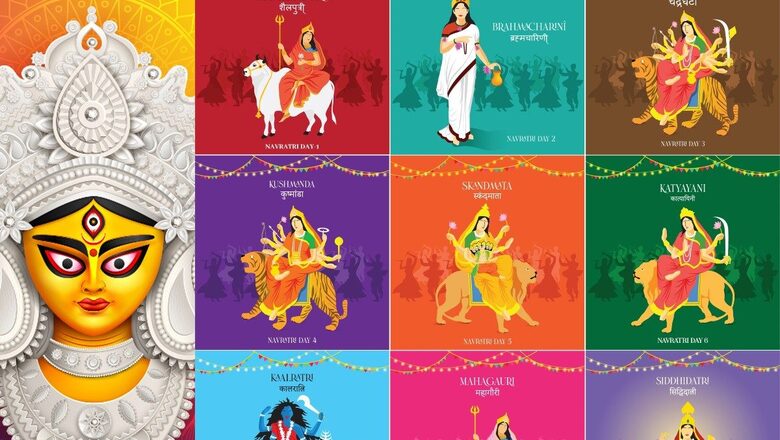
views
Navratri, which means “nine nights,” is one of the most prominent and extensively observed Hindu festivals in India. It is observed to worship the deity Durga, a manifestation of Adi Parashakti, the greatest goddess. Navratri is annually celebrated with great zeal throughout the country. This year, Navratri celebrations will begin on Sunday, October 15 and culminate on Tuesday, October 24.
Navdurga, the nine incarnations of Goddess Durga, is honoured during the sacred Navratri festival. Every night, a different avatar of Goddess Durga is worshipped. According to Drik Panchang, the notion of Navdurga stems from Goddess Parvati, who is regarded as the ultimate power among all Goddesses. Devotees worship Maa Durga’s nine incarnations and pray for prosperity in their houses and lives.
Here are the 9 avatars of Goddess Durga
Shailputri (October 15)
Maa Shailputri is worshipped on the first day. She is also referred to as Parvati and Hemavati. The name Shailputri is said to be a combination of the words Shaila, which in Hindi means mountain, and Putri, which means daughter. She is referred to as Mountain King Himalaya’s daughter.
WATCH: Navratri Special: 9 Avatars Of Goddess Durga
She rides a bull and carries a lotus blossom and a trident in each of her two hands. She is regarded as Goddess Parvati’s earlier incarnation. She is revered as the bringer of wealth and success.
Brahmacharini (October 16)
The goddess Brahmacharini is honoured on the second day of Navratri. To win Lord Shiva’s hand in marriage, Goddess Brahmacharini undertook tremendous penance. Goddess Brahmacharini is the name given to her unmarried form. She is holding a Kamandal and a Japa Mala (string of beads) in each hand. She wears a white saree and is barefoot. She is said to prefer the colour white, hence to win her favour, devotees present Maa Brahmacharini with white flowers and clothes.
Chandraghanta (October 17)
On the third day of Navratri, the Goddess Chandraghanta is worshipped. She is Goddess Parvati’s wedded form. After marrying Lord Shiva, she began decorating her forehead with half Chandra (Moon), earning her the name Goddess Chandraghanta. The tigress is Goddess Chandraghanta’s mount. In her hands are chakra, mace, japa mala, kalasa (pot), lotus flower, bow, arrow, and kamandal. She is well-known for her battles against the universe’s wicked powers.
Kushmanda (October 18)
Devi Kushmanda is honoured on the fourth day of Navratri. She is regarded as the universe’s creator and manages the energy needed to produce new things. The lioness serves as her mount. She is referred to as Aadi Mata, the supreme mother who gave birth to the universe. She bestows fame, and wealth upon her followers.
WATCH: 9 Colours Of Navratri And Their Significance
Skandamata (October 19)
On the fifth day of Navratri, devotees worship the goddess Skandamata. Goddess Skandmata is a four-armed deity who bears a lotus in each of her two arms. One of her right hands is in the Abhaya Mudra, which dispels all anxieties and evil, while the other is holding the infant Skanda or Kartikay on her lap. She is often referred to as Goddess Padmasana because of her lotus-seated position. Her son Kartikeya, who is also known as Skanda, is the source of the name. In Sanskrit, Skandamata is referred to as the mother of Skanda, the warrior deity and son of Lord Shiva.
Katyayani (October 20)
Goddess Katyayani is worshipped on the sixth day. She assumed the guise of Katyayani in order to defeat the demon Mahisasura. She has 10 hands and rides atop the lion. Katyayani is her given name since she is the daughter of Sage Katyaayan. According to mythology, Sage Katyaayan worshipped Goddess Durga, and Maa Durga, satisfied with the sage’s devotion, decided to take birth as his daughter. Maa Katyayani grants her devotees freedom from all sin and monetary prosperity.
Kalaratri (October 21)
The goddess Durga’s Kalaratri avatar is worshipped on Saptami, the seventh day. She supposedly sacrificed her golden skin in order to exterminate demons. Goddess Durga manifests in her most vicious form at Kalaratri. She has four arms and is portrayed as having a dark complexion. Her left hands are holding a sword and a hook, while her right hands are in the Abhaya and Varada mudras.
Mahagauri (October 22)
To the goddess Mahagauri, the eighth day is devoted. The meaning of the name is “moon bright,” which refers to someone who is very bright or intelligent. She is mounted on a white bull. Additionally, known as Shwetambardhara, she only wears white clothes. She bestows prosperity and happiness upon her followers.
Siddhidhatri (October 23)
Goddess Siddhidhatri is worshipped on the last day, Navmi tithi. Goddess Siddhidhatri rides a lion on a lotus flower. She is represented with four hands, one right hand holding a Gada, the other right hand holding a Chakra, one left hand holding a lotus flower, and the other left hand holding a Shankh. Devotees pray to Goddess Siddhidhatri for Siddhi and Nidhi, knowledge and riches.
(All videos: @narendramodi/X, formerly Twitter)




















Comments
0 comment